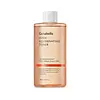What's inside
What's inside
 Key Ingredients
Key Ingredients

 Benefits
Benefits

 Concerns
Concerns

 Ingredients Side-by-side
Ingredients Side-by-side

Hydrolyzed Dna
Skin ConditioningMelaleuca Alternifolia Leaf Extract
PerfumingBiosaccharide Gum-4
Skin ConditioningWater
Skin ConditioningPropanediol
SolventLocked Nucleic Acid-1
Skin ConditioningPortulaca Oleracea Extract
Skin ConditioningTrehalose
HumectantCentella Asiatica Extract
CleansingFicus Carica Fruit Extract
HumectantPyrus Malus Flower Extract
Skin ConditioningHydrogenated Lecithin
EmulsifyingBetaine
HumectantC12-14 Pareth-12
EmulsifyingSodium Citrate
BufferingCitric Acid
BufferingDisodium EDTA
Gluconolactone
Skin ConditioningCeramide NP
Skin ConditioningParfum
MaskingEthylhexylglycerin
Skin ConditioningButylphenyl Methylpropional
PerfumingLinalool
PerfumingAlpha-Isomethyl Ionone
PerfumingLimonene
PerfumingHydrolyzed Dna, Melaleuca Alternifolia Leaf Extract, Biosaccharide Gum-4, Water, Propanediol, Locked Nucleic Acid-1, Portulaca Oleracea Extract, Trehalose, Centella Asiatica Extract, Ficus Carica Fruit Extract, Pyrus Malus Flower Extract, Hydrogenated Lecithin, Betaine, C12-14 Pareth-12, Sodium Citrate, Citric Acid, Disodium EDTA, Gluconolactone, Ceramide NP, Parfum, Ethylhexylglycerin, Butylphenyl Methylpropional, Linalool, Alpha-Isomethyl Ionone, Limonene
Water
Skin ConditioningButylene Glycol
HumectantGlycerin
HumectantPropanediol
SolventNiacinamide
SmoothingDipropylene Glycol
Humectant1,2-Hexanediol
Skin ConditioningPanthenol
Skin ConditioningSodium Dna
Skin ConditioningCitric Acid
BufferingEthylhexylglycerin
Skin ConditioningAdenosine
Skin ConditioningXanthan Gum
EmulsifyingSodium Citrate
BufferingDisodium EDTA
Sodium Hyaluronate
HumectantPortulaca Oleracea Extract
Skin ConditioningCentella Asiatica Extract
CleansingHydrolyzed Vegetable Protein
Skin ConditioningMaltodextrin
AbsorbentBeta-Glucan
Skin ConditioningTocopherol
AntioxidantHyaluronic Acid
HumectantHydrolyzed Sodium Dna
Skin ConditioningHydroxypropyltrimonium Hyaluronate
Madecassoside
AntioxidantHydrolyzed Hyaluronic Acid
HumectantTripeptide-1
Skin ConditioningSodium Acetylated Hyaluronate
HumectantSodium Hyaluronate Crosspolymer
HumectantMadecassic Acid
Skin ConditioningHydrolyzed Sodium Hyaluronate
Skin ConditioningAsiatic Acid
Skin ConditioningAsiaticoside
AntioxidantAcetyl Hexapeptide-8
HumectantPotassium Hyaluronate
Skin ConditioningWater, Butylene Glycol, Glycerin, Propanediol, Niacinamide, Dipropylene Glycol, 1,2-Hexanediol, Panthenol, Sodium Dna, Citric Acid, Ethylhexylglycerin, Adenosine, Xanthan Gum, Sodium Citrate, Disodium EDTA, Sodium Hyaluronate, Portulaca Oleracea Extract, Centella Asiatica Extract, Hydrolyzed Vegetable Protein, Maltodextrin, Beta-Glucan, Tocopherol, Hyaluronic Acid, Hydrolyzed Sodium Dna, Hydroxypropyltrimonium Hyaluronate, Madecassoside, Hydrolyzed Hyaluronic Acid, Tripeptide-1, Sodium Acetylated Hyaluronate, Sodium Hyaluronate Crosspolymer, Madecassic Acid, Hydrolyzed Sodium Hyaluronate, Asiatic Acid, Asiaticoside, Acetyl Hexapeptide-8, Potassium Hyaluronate
 Reviews
Reviews

Ingredients Explained
These ingredients are found in both products.
Ingredients higher up in an ingredient list are typically present in a larger amount.
Centella Asiatica Extract (Centella) is derived from an herb native to Southeast Asia. It is famous for its anti-inflammatory and soothing properties.
Centella is rich in antioxidants and amino acids, such as Madecassic Acid and Asiaticoside.
Studies show the compounds in centella help with:
The combination of all these properties makes centella effective at soothing, hydrating, and protecting the skin.
Other great components of centella include Vitamin A, vitamin C, several B vitamins, and Asiatic Acid.
Fun fact: Centella has been used as a medicine and in food for many centuries. As a medicine, it is used to treat burns, scratches, and wounds.
Learn more about Centella Asiatica ExtractCitric Acid is an alpha hydroxy acid (AHA) naturally found in citrus fruits like oranges, lemons, and limes.
Like other AHAs, citric acid can exfoliate skin by breaking down the bonds that hold dead skin cells together. This helps reveal smoother and brighter skin underneath.
However, this exfoliating effect only happens at high concentrations (20%) which can be hard to find in cosmetic products.
Due to this, citric acid is usually included in small amounts as a pH adjuster. This helps keep products slightly more acidic and compatible with skin's natural pH.
In skincare formulas, citric acid can:
While it can provide some skin benefits, research shows lactic acid and glycolic acid are generally more effective and less irritating exfoliants.
Most citric acid used in skincare today is made by fermenting sugars (usually from molasses). This synthetic version is identical to the natural citrus form but easier to stabilize and use in formulations.
Read more about some other popular AHA's here:
Learn more about Citric AcidDisodium EDTA plays a role in making products more stable by aiding other preservatives.
It is a chelating agent, meaning it neutralizes metal ions that may be found in a product.
Disodium EDTA is a salt of edetic acid and is found to be safe in cosmetic ingredients.
Learn more about Disodium EDTAEthylhexylglycerin (we can't pronounce this either) is commonly used as a preservative and skin softener. It is derived from glyceryl.
You might see Ethylhexylglycerin often paired with other preservatives such as phenoxyethanol. Ethylhexylglycerin has been found to increase the effectiveness of these other preservatives.
This extract comes from Purslane, a succulent. It has anti-inflammatory, antioxidant, and hydrating properties.
Purslane is very nutritious. It contains omega-3 fatty acids, NMFs, many vitamins, minerals, and antioxidants. The vitamins found in purslane include: Vitamin C, Vitamin A, and Vitamin E.
Fun fact: Purslane is a succulent with an extensive habitat. It is used in traditional Korean medicine to treat irritated skin.
Nowadays, purslane is becoming a superfood due to its highly nutritious content.
Learn more about Portulaca Oleracea ExtractPropanediol is an all-star ingredient. It softens, hydrates, and smooths the skin.
It’s often used to:
Propanediol is not likely to cause sensitivity and considered safe to use. It is derived from corn or petroleum with a clear color and no scent.
Learn more about PropanediolSodium Citrate is the sodium salts of citric acid. In skincare, it is used to alter pH levels and acts as a preservative.
Its main functions are to maintain the pH of a product and neutralize metal ions.
The acidity of our skin is maintained by our glands and skin biome; normal pH level of skin is slightly acidic (~4.75-5.5).
Being slightly acidic allows our skin to create an "acid mantle". This acid mantle is a thin barrier that protects our skin from bacteria and contaminants.
Learn more about Sodium CitrateWater. It's the most common cosmetic ingredient of all. You'll usually see it at the top of ingredient lists, meaning that it makes up the largest part of the product.
So why is it so popular? Water most often acts as a solvent - this means that it helps dissolve other ingredients into the formulation.
You'll also recognize water as that liquid we all need to stay alive. If you see this, drink a glass of water. Stay hydrated!
Learn more about Water